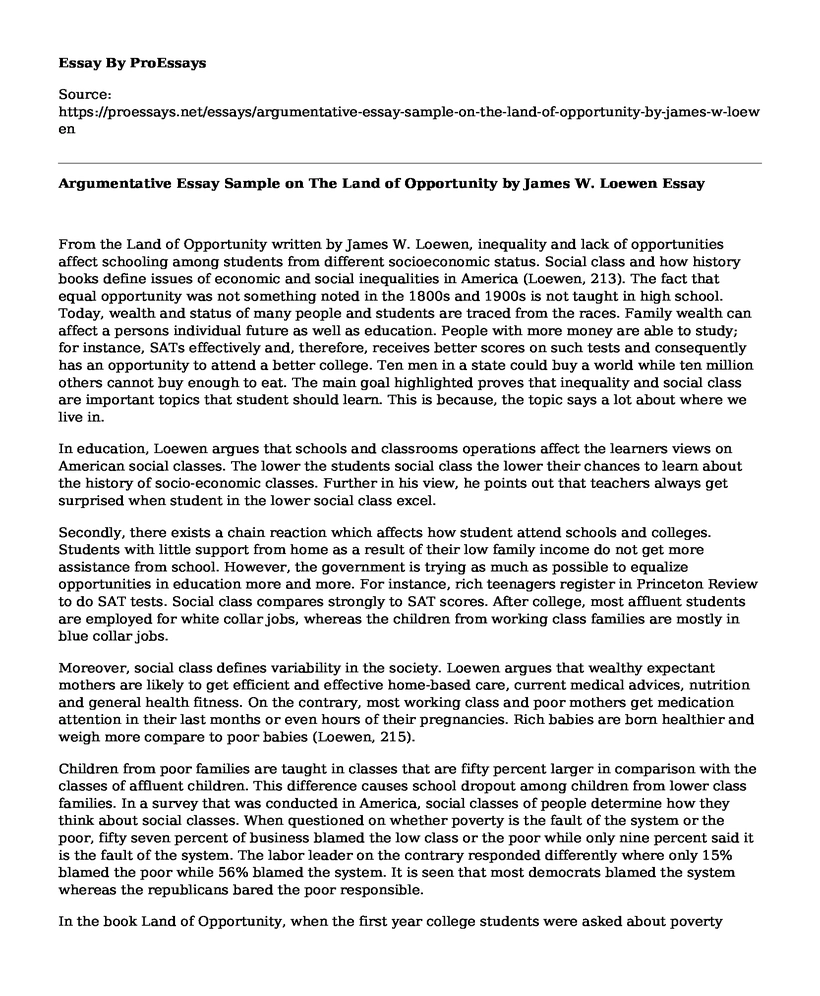From the Land of Opportunity written by James W. Loewen, inequality and lack of opportunities affect schooling among students from different socioeconomic status. Social class and how history books define issues of economic and social inequalities in America (Loewen, 213). The fact that equal opportunity was not something noted in the 1800s and 1900s is not taught in high school. Today, wealth and status of many people and students are traced from the races. Family wealth can affect a persons individual future as well as education. People with more money are able to study; for instance, SATs effectively and, therefore, receives better scores on such tests and consequently has an opportunity to attend a better college. Ten men in a state could buy a world while ten million others cannot buy enough to eat. The main goal highlighted proves that inequality and social class are important topics that student should learn. This is because, the topic says a lot about where we live in.
In education, Loewen argues that schools and classrooms operations affect the learners views on American social classes. The lower the students social class the lower their chances to learn about the history of socio-economic classes. Further in his view, he points out that teachers always get surprised when student in the lower social class excel.
Secondly, there exists a chain reaction which affects how student attend schools and colleges. Students with little support from home as a result of their low family income do not get more assistance from school. However, the government is trying as much as possible to equalize opportunities in education more and more. For instance, rich teenagers register in Princeton Review to do SAT tests. Social class compares strongly to SAT scores. After college, most affluent students are employed for white collar jobs, whereas the children from working class families are mostly in blue collar jobs.
Moreover, social class defines variability in the society. Loewen argues that wealthy expectant mothers are likely to get efficient and effective home-based care, current medical advices, nutrition and general health fitness. On the contrary, most working class and poor mothers get medication attention in their last months or even hours of their pregnancies. Rich babies are born healthier and weigh more compare to poor babies (Loewen, 215).
Children from poor families are taught in classes that are fifty percent larger in comparison with the classes of affluent children. This difference causes school dropout among children from lower class families. In a survey that was conducted in America, social classes of people determine how they think about social classes. When questioned on whether poverty is the fault of the system or the poor, fifty seven percent of business blamed the low class or the poor while only nine percent said it is the fault of the system. The labor leader on the contrary responded differently where only 15% blamed the poor while 56% blamed the system. It is seen that most democrats blamed the system whereas the republicans bared the poor responsible.
In the book Land of Opportunity, when the first year college students were asked about poverty levels in their families, most of them blamed the poor for their poverty. These students did not understand the reasons for unequal opportunities in America as well as how the social structures defined the people around and how these ideas relate to peoples lives and class.
Despite the precise causes of class disparity, most American textbooks omit the history of social classes in America. Loewens view was that if the text books were changed, they would be important for social functions and could teach parents, children and their communities how they came to be. These textbooks; however, omit a thorough social class discussions hence depriving student the information on themselves and their communities (Loewen, 213). Textbooks condition the wealthy learners to believe that they deserve their privileges and encourage the poor students to accept their positions in the society. The lack of clear information regarding social class denies the working students the understanding of how the system barred from them and therefore changing the system.
Finally, one of the major instances on how textbooks maintain the rigidity of class in America is the way they discuss the issue of immigration. This is because they devote so many pages to discuss immigration and stressing more on the number of people who rose from poverty to wealth other than the many others who remained improvised when they arrived in us.
Work Cited
Loewen, James W. Lies my teacher told me: Everything your American history textbook got wrong. The New Press, 2008.
Cite this page
Argumentative Essay Sample on The Land of Opportunity by James W. Loewen. (2021, Apr 09). Retrieved from https://proessays.net/essays/argumentative-essay-sample-on-the-land-of-opportunity-by-james-w-loewen
If you are the original author of this essay and no longer wish to have it published on the ProEssays website, please click below to request its removal:
- Personal Statement: Engineering
- Rubrics to Assess English Language Learners
- Religion Essay Example: Criticisms of Recognition of Mother Teresa as a Catholic Saint
- Racial Discrimination in Education Essay
- Hearing Both Sides of an Argument Essay
- Essay on Student Affairs: Broadening Functional Areas for Student Success
- College Life: Enjoyable for Some, Difficult for Others - Essay Sample







